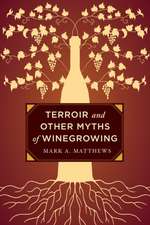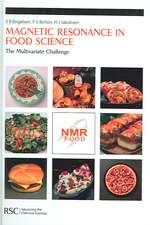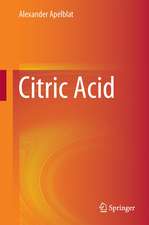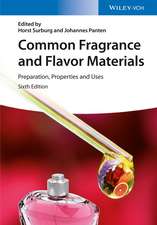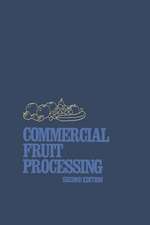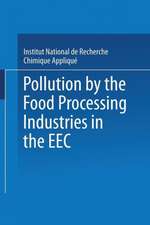Pseudocereals and Less Common Cereals: Grain Properties and Utilization Potential
Editat de Peter S. Belton, John R.N. Tayloren Limba Engleză Paperback – 22 ian 2011
| Toate formatele și edițiile | Preț | Express |
|---|---|---|
| Paperback (1) | 560.25 lei 38-44 zile | |
| Springer Berlin, Heidelberg – 22 ian 2011 | 560.25 lei 38-44 zile | |
| Hardback (1) | 644.82 lei 43-57 zile | |
| Springer Berlin, Heidelberg – 10 iul 2002 | 644.82 lei 43-57 zile |
Preț: 560.25 lei
Preț vechi: 700.31 lei
-20% Nou
Puncte Express: 840
Preț estimativ în valută:
107.22€ • 111.52$ • 88.51£
107.22€ • 111.52$ • 88.51£
Carte tipărită la comandă
Livrare economică 09-15 aprilie
Preluare comenzi: 021 569.72.76
Specificații
ISBN-13: 9783642076916
ISBN-10: 3642076912
Pagini: 288
Ilustrații: XVIII, 270 p.
Dimensiuni: 155 x 235 x 15 mm
Ediția:Softcover reprint of hardcover 1st ed. 2002
Editura: Springer Berlin, Heidelberg
Colecția Springer
Locul publicării:Berlin, Heidelberg, Germany
ISBN-10: 3642076912
Pagini: 288
Ilustrații: XVIII, 270 p.
Dimensiuni: 155 x 235 x 15 mm
Ediția:Softcover reprint of hardcover 1st ed. 2002
Editura: Springer Berlin, Heidelberg
Colecția Springer
Locul publicării:Berlin, Heidelberg, Germany
Public țintă
Professional/practitionerCuprins
J.R.N. Taylor, P.S. Belton: Introduction.- P.R. Shewry: The Major Seed Storage Proteins of Spelt Wheat, Sorghum, Millets and Pseudocereals.- P.S. Belton, J.R.N. Taylor: Sorghum.- J.R.N. Taylor, M.L Parker: Quinoa.- P. Biacs, E. Aubrecht, I. Lder, J. Lajos: Buckwheat.- R. Cubadda, E. Marconi: Spelt Wheat.- A Babatunde Obilana, E. Manyasa: Millets.- E. Berghofer, R. Schoenlechner: Grain Amaranth.
Recenzii
From the reviews:
"The purpose of this book is to inform, stimulate interest, and promote knowledge-sharing about the structure, chemistry, nutritional value, processing technologies, and current and potential uses of a number of important but underutilised food grains. … This book provides a useful starting point for researchers, extension agents, and commercial companies … ." (Jim Ellls-Jones, Mountain Research and Development, Vol. 24 (3), August, 2004)
"The main purpose of the editors together with a team of experienced co-authors is not only to inform, but also to stimulate interest in … food grains. This special volume is warmly recommended to scientists and practitioners in the disciplines of food technology as a comprehensive updated collection of these important, but still underestimated pseudo- and less common cereals." (AFS – Advances in Food Science, Vol. 25 (2), 2003)
"In this book, the authors and contributors, leading grain scientists from Europe and Africa, examine in particular possible food-processing methods and technologies for certain grain crops … with the potential for worldwide cultivation. … This book provides valuable basic information and useful hints for the food industry and related technological research institutions." (G. Sauerbeck and J. M. Greef, Journal of Agronomy and Crop Science, Vol. 189 (3), 2003)
"The book extensively covers up-to-date knowledge on six grain cereals … . The authors illustrate the potential from such species … . The strength of the book lies in its capacity to go well beyond a description of the species … . Technological properties are also well treated, providing an excellent insight to geneticists or breeders that may have an interest in distilling specific targets for their activities. … An excellent contribution to the knowledge on a few neglected crops with great potential to mankind." (Paolo Donini, Plant Genetic Resources, Vol. 1 (1),2003)
"The purpose of this book is to inform, stimulate interest, and promote knowledge-sharing about the structure, chemistry, nutritional value, processing technologies, and current and potential uses of a number of important but underutilised food grains. … This book provides a useful starting point for researchers, extension agents, and commercial companies … ." (Jim Ellls-Jones, Mountain Research and Development, Vol. 24 (3), August, 2004)
"The main purpose of the editors together with a team of experienced co-authors is not only to inform, but also to stimulate interest in … food grains. This special volume is warmly recommended to scientists and practitioners in the disciplines of food technology as a comprehensive updated collection of these important, but still underestimated pseudo- and less common cereals." (AFS – Advances in Food Science, Vol. 25 (2), 2003)
"In this book, the authors and contributors, leading grain scientists from Europe and Africa, examine in particular possible food-processing methods and technologies for certain grain crops … with the potential for worldwide cultivation. … This book provides valuable basic information and useful hints for the food industry and related technological research institutions." (G. Sauerbeck and J. M. Greef, Journal of Agronomy and Crop Science, Vol. 189 (3), 2003)
"The book extensively covers up-to-date knowledge on six grain cereals … . The authors illustrate the potential from such species … . The strength of the book lies in its capacity to go well beyond a description of the species … . Technological properties are also well treated, providing an excellent insight to geneticists or breeders that may have an interest in distilling specific targets for their activities. … An excellent contribution to the knowledge on a few neglected crops with great potential to mankind." (Paolo Donini, Plant Genetic Resources, Vol. 1 (1),2003)
Textul de pe ultima copertă
This book, written by leading grain scientists from Europe and Africa, examines six such grains that have been important food crops in various parts of the world and have the potential for much greater and more widespread use. The chemistry, nutritional value, food processing technologies and potential applications of three true cereals: sorghum, spelt wheat and the major millet species, and three dicotyledonous pseudocereals: grain amaranth, buckwheat and quinoa are discussed. Just three cereal grains account for more than 75% of all grains produced worldwide. This causes high risks for the future of humankind via catastrophic food crop failures and is detrimental to our long-term health (deficiencies of micronutritients, food allergenes and intolerances). In addition, the intensive cultivation practices needed to produce the required high yields of these cereals is frequently leading to environmental degradation, and they are often inappropriate in the Developing World.
Caracteristici
An up to date review of the state of knowledge of pseudocereals and some less well-known cereals by acknowledged experts in their fields Aimed at academics and professionals who are involved in biochemistry, nutrition, processing or use of these plants and will be of special interest to those concerned with development issues and food or environmental security Includes supplementary material: sn.pub/extras

